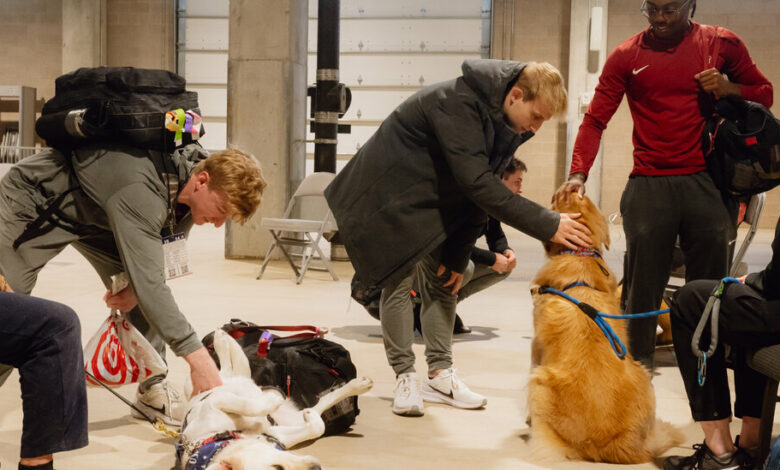USA Gymnastics gets warm and cozy at the Olympic team trials

Just before this week’s U.S. Olympic gymnastics team trials, a very enthusiastic worker flew to the host city of Minneapolis with protein treats, a collection of colorful bandanas and a stuffed turtle. Upon arrival, he was given a USA Gymnastics badge to wear around his neck, identifying him as “Goodest Boy.”
His name is Beacon, and he’s a 4-year-old golden retriever therapy dog with a soft blond coat that smells of champagne and raspberry shampoo. His job is to de-stress American gymnasts during their big events, including the trials, the competition that will determine the U.S. team for next month’s Olympic Games in Paris.
“Beacon, I love you so much!” said national team gymnast Joscelyn Roberson as she lay next to him for 30 minutes after a training session at the recent national championships in Fort Worth. “He’s so cute! I’ve been telling people this is the best thing USA Gymnastics could do for us.”
Beacon, run by its owner Tracey Callahan Molnar, a former rhythmic gymnast and longtime coach, plays a warm and friendly role in USA Gymnastics’ effort to promote a culture that protects the well-being of its athletes.
For decades, the culture was quite the opposite: At every level of the sport, it was not uncommon for tyrannical coaches to scare young athletes into submission and silence while they – or other adults – abused those gymnasts physically, emotionally, or both.
In 2016, a sexual abuse scandal involving a former national team doctor, Lawrence G. Nassar, shed a harsh light on what was happening, leading sponsors to drop USA Gymnastics. Nassar is now in prison for molesting hundreds of girls and women.
At the 2021 Olympic Games in Tokyo, Simone Biles, the greatest gymnast in history, withdrew from most of her events due to a mental block. The decision made her as famous for what she didn’t accomplish at those Games as for what she did as the most decorated athlete in her sport.
“There’s no doubt that there’s a lesson learned from Tokyo in terms of mental well-being, which is so critically important,” said USA Gymnastics CEO Li Li Leung. “But if we just start a therapy dog program, OK, great, you’ve got a nice, cute, furry dog to pet. But it doesn’t mean anything if you don’t have everything in place.”
Since taking over in 2019, Leung, a former elite gymnast and former NBA executive, has focused on making her sport a better place for its athletes, both physically and mentally. She’s made progress, but it’s a never-ending process, she said.
At the national games, a sports psychologist from the United States Olympic & Paralympic Committee conducted mindfulness sessions in a dark, quiet room in the arena. Carly Patterson, the 2004 Olympics all-around champion, was brought in to give the female gymnasts pep talks and advice. Local doctors and mental health professionals are now on call at USA Gymnastics events as part of an emergency mental health plan put in place two years ago.
Sponsors have returned, including Nike, Xfinity, Samsonite and Skippy, and Leung said all of the federation’s sponsors must acknowledge that a portion of their money will go toward mental wellness programs, including therapy visits for coaches and athletes.
“They have completely turned things around and now think clearly: ‘What does the athlete need?’ and it’s so much fun,” said three-time Olympian Sam Mikulak, who struggled with anxiety and depression when the 2020 Tokyo Olympics were postponed due to the Covid-19 pandemic.
“Sometimes just being present is all someone needs to get through a tough time,” says Mikulak, who is now a coach. “And a dog brings that threefold.”
When it comes to mental health initiatives in gymnastics, Beacon is the star of the show.
He is Callahan Molnar’s service dog and they are inseparable. At home in Pasadena, California, near Los Angeles, they volunteer at a hospital and also go to the nearby California Institute of Technology, where students pet Beacon to relax.
“I always felt like it would be selfish if I kept him for myself,” she said.
Callahan Molnar, who turns 65 next week, experienced the power of a therapy dog when her husband, David Molnar, underwent chemotherapy to treat cancer. He told her that their own dog, Tulsa, should be a therapy dog.
“That dog in the hospital helped distract him from, you know, the hard stuff,” Callahan Molnar said, adding that Tulsa began working as a therapy dog six months after David’s death in 2013. “I’m so sorry he didn’t. I can’t see it happening. This is kind of my way of honoring him.”
After Tulsa passed away, Callahan got Molnar Beacon as a puppy and eventually enrolled him in therapy dog training. A few years ago, she and Caroline Hunter, director of USA Gymnastics’ rhythmic gymnastics program, started discussing the idea of bringing him to events.
Leung was all in. She brought her own dog — a Siberian husky named Suma — into the federation’s office during the pandemic, and staff members dropped to the floor to pet her. “They just melted,” she said, adding that Suma is now a therapy dog who works at the trials.
Dr. Maggie O’Haire, associate dean for research at the University of Arizona College of Veterinary Medicine, remains fascinated by the fact that people can have such strong reactions to dogs they’ve never met before. She’s an expert in human interaction with dogs, she said petting a dog lowers people’s perception of stressful situations, and also lowers their blood pressure, heart rate, and cortisol, the body’s stress hormone. Bonding with a dog has even more benefits.
“It’s a signal of support and comfort and something that’s very valuable in these environments when you’re away from home,” said Dr. O’Haire.
Therapy dogs are often used in places where there is extreme stress, such as in cities after a shooting, at universities during exams, at airports and, recently, at sporting events.
This month alone, more than 60 local therapy dog teams worked at the USA Swimming Olympic trials in Indianapolis at the request of athletes. Swimmers lined up to pet the dogsallowing them to have “a moment of normalcy” during a period of high pressure, said Ashleigh Coster, executive director of Paws & Think, Inc., the group that provided the therapy teams.
Beacon was supposed to be the only therapy dog at his first event, an elite qualifier for rhythmic gymnasts in Indianapolis last year. But when Callahan Molnar learned that 300 athletes would be there, she enlisted the help of three local therapy dog organizations. Eleven more dogs, ranging from a tiny, fluffy Keeshond to a 100-pound Great Pyrenees, volunteered.
During the national championships, Callahan Molnar oversaw 19 teams of handlers and their good dogs, including Gus, the Cavalier King Charles spaniel; Gilly, the Scottish terrier; Twiggy, the mini beagle; and many golden retrievers.
Luna, a white and curvy American Staffordshire terrier, wore a huge pink bow and wagged her tail like a windshield wiper on high. A particularly enthusiastic yellow Labrador named Molly dramatically fell over for a belly rub at the slightest glance and licked the chalk off the gymnasts’ hands and legs. Beacon worked from morning to evening.
“Not every dog is suited for this, but it turns out he’s good at it and he really enjoys it, which was a really important part of it for me,” Callahan Molnar said. “Even if he’s tired, even if he’s been working for 12 hours, as soon as he hears his name, he’s like, ‘I’m ready and I want to say hi. Who wants to be around me?'”
It turned out that there were many gymnasts who shouted his name when they saw him. Judges, coaches and security guards also couldn’t resist a pat on the head or a drive-by belly rub.
Brody Malone, a normally stoic gymnast who competed in Tokyo, was a giggling fan in Beacon. He said, “I love this dog! Who wouldn’t want to take a break from all that stress to love a dog for a few minutes?”
Shilese Jones, a favorite to make the team for the Paris Games, traded a bathroom break for time with Beacon during last year’s nationals.
“I said, forget the bathroom, is Beacon there?” she said. “I feel like he kind of shuts out reality and sometimes that’s good for us, so we don’t think too much.”
In this year’s subjects, they reunited like long-lost friends. He jumped up when he saw her, licked her face, and rested his large head on her open palm.
“Oh, he remembered me!” Jones said with a laugh.
Jones, who battled a shoulder injury that forced her to withdraw from the national championships, said Beacon made her feel better mentally — and physically, too.
“He distracts me from the reality of the pain,” she said, scratching Beacon behind the ears.
Beacon and Chester, another golden retriever, provided similar support to gymnasts when the new national team was announced earlier this month. Gymnasts who were on the team donned new Team USA tracksuits. Those who weren’t stood just a few feet away. Some tried to control their breathing so they wouldn’t cry. Others had tears in their eyes.
Beacon licked the tears from a gymnast’s cheek and she smiled as he grabbed one of her slippers and tried to walk away with it.
A similar scenario will likely unfold at the Olympic Trials, where just five men and five women will make the U.S. team for the Paris Games this summer. USA Gymnastics plans to have psychologists on site for the unnamed athletes, and there will be a private room for those gymnasts and their families.
Beacon will also be in the arena to watch the gymnasts, whether they make the team or not.




